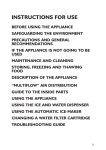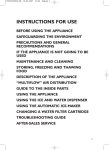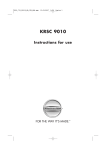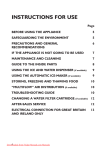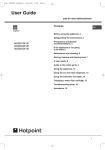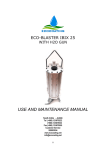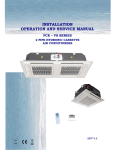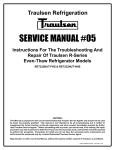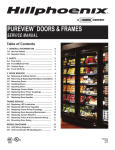Download Smeg FA550XBI2 side-by-side refrigerator
Transcript
INSTRUCTIONS FOR USE BEFORE USING THE APPLIANCE SAFEGUARDING THE ENVIRONMENT PRECAUTIONS AND GENERAL RECOMMENDATIONS IF THE APPLIANCE IS NOT GOING TO BE USED MAINTENANCE AND CLEANING STORING, FREEZING AND THAWING FOOD DESCRIPTION OF THE APPLIANCE “MULTIFLOW” AIR DISTRIBUTION GUIDE TO THE INSIDE PARTS USING THE APPLIANCE USING THE ICE AND WATER DISPENSER USING THE AUTOMATIC ICE-MAKER CHANGING A WATER FILTER CARTRIDGE TROUBLESHOOTING GUIDE 21 BEFORE USING THE APPLIANCE Your new appliance is designed exclusively for domestic use. After unpacking the appliance, make sure it is not damaged and that the door closes properly. Any damage must be reported to the dealer within 24 hours of delivery of the appliance. Installation and the electrical connection must be carried out by a qualified technician, according to the manufacturer’s instructions and local safety regulations. Clean the inside of the appliance before using it. Wait at least two hours before switching the appliance on, to ensure that the refrigerant circuit is fully efficient. SAFEGUARDING THE ENVIRONMENT 1. Packing The packing material is 100% recyclable and bears the recycling symbol. For disposal, comply with the local regulations. Keep the packing materials (plastic bags, polystyrene parts, etc.) out of the reach of children, as they are a potential source of danger. 2. Scrapping/Disposal The appliance is manufactured using recyclable material. This appliance is marked in compliance with European Directive 2002/96/EC on Waste Electrical and Electronic Equipment (WEEE). By ensuring the correct disposal of this appliance, you can help prevent potentially negative consequences for the environment and the health of persons. The symbol on the appliance, or on the accompanying documents, indicates that this appliance should not be treated as domestic waste but must be taken to a special collection centre for the recycling of electrical and electronic equipment. When scrapping the appliance, make it unusable by cutting off the power cable and removing the doors and shelves so that children cannot easily climb inside and become trapped. Scrap the appliance in compliance with local regulations on waste disposal, taking it to a special collection centre; do not leave the appliance unattended even for a few days, since it is a potential source of danger for children. For further information on the treatment, recovery and recycling of this product, contact your competent local office, the household waste collection service or the shop where you purchased the appliance. 22 Information: This appliance does not contain CFCs. The refrigerant circuit contains R134a (HFC) or R600a (HC) (see the rating plate inside the appliance). Appliances with Isobutane (R600a): isobutane is a natural gas without environmental impact, but is flammable. Therefore, make sure the refrigerant circuit pipes are not damaged. Declaration of conformity • This appliance has been designed for preserving food and is manufactured in compliance with Regulation (CE) No. 1935/2004. • This appliance has been designed, manufactured and marketed in compliance with: - safety objectives of the “Low Voltage” Directive 2006/95/CE (which replaces 73/23/CEE and subsequent amendments); - the protection requirements of Directive “EMC” 89/336/EEC amended by Directive 93/68/EEC. Electrical safety of the appliance can only be guaranteed if it is correctly connected to an approved earthing system. PRECAUTIONS AND GENERAL RECOMMENDATIONS INSTALLATION SAFETY • The appliance must be handled and installed by two or more persons. • Be careful not to damage the floors (e.g. parquet) when moving the appliance. • During installation, make sure the appliance does not damage the power cable. • Make sure the appliance is not near a heat source. • To guarantee adequate ventilation, leave a space on both sides and above the appliance and follow the installation instructions. • Keep the appliance ventilation openings free. • Do not damage the appliance refrigerant circuit pipes. • Install and level the appliance on a floor strong enough to take its weight and in a place suitable for its size and use. • Install the appliance in a dry and well-ventilated place. The appliance is arranged for operation in places where the temperature comes within the following ranges, according to the climatic class given on the rating plate. The appliance may not work properly if it is left for a long time at a temperature outside the specified range. • Do not store or use petrol, flammable liquids or gas in the vicinity of this or other electrical appliances. The fumes can cause fires or explosions. • Do not use mechanical, electric or chemical means other than those recommended by the Manufacturer to speed up the defrost process. • Do not use or place electrical devices inside the appliance compartments if they are not of the type expressly authorised by the Manufacturer. • This appliance is not designed for use by young children or the infirm without supervision. • To avoid the risk of children becoming trapped and suffocating, do not allow them to play or hide inside the appliance. • Do not swallow the contents (non-toxic) of the ice packs (in some models). • Do not eat ice cubes or ice lollies immediately after taking them out of the freezer since they may cause cold burns. Climatic Class SN N ST T Amb. T. (°C) From 10 to 32 From 16 to 32 From 16 to 38 From 16 to 43 Amb. T. (°F) From 50 to 90 From 61 to 90 From 61 to 100 From 61 to 110 • Make sure the voltage specified on the rating plate corresponds to that of your home. • Do not use single/multi adapters or extension cords. • For the water connection, use the pipe supplied with the new appliance; do not reuse that of the previous appliance. • Power cable modification or replacement must only be carried out by qualified personnel. • It must be possible to disconnect the appliance from the power supply by unplugging it or by means of a mains two-pole switch installed upstream of the socket. USE • Before carrying out any maintenance or cleaning operation, unplug the appliance or disconnect it from the power supply. • All appliances equipped with an automatic icemaker and water dispenser must be connected to a water supply that only delivers drinking water (with mains water pressure of between 0.17 and 0.81 Mpa (1.7 and 8.1 bar)). Automatic ice-makers and/or water dispensers not directly connected to the water supply must be filled with drinking water only. • Use the refrigerator compartment only for storing fresh food and the freezer compartment only for storing frozen food, freezing fresh food and making ice cubes. • Do not store glass containers with liquids in the freezer since they may burst. The Manufacturer declines any liability if the above advice and precautions are not respected. 23 IF THE APPLIANCE IS NOT GOING TO BE USED In case of power failures of up to 24 hours Keep the doors of the appliance closed. In this way the stored food will stay cold as long as possible. For further information see chapter “Using the appliance”, section “Black-out alarm”. If - the appliance is not going to be used Disconnect the appliance from the power supply. Remove all the food if you are going away for more than three weeks. If the appliance has an automatic ice-maker: 1. Shut off the water supply to the automatic ice-maker. 2. Empty the ice bucket. - Leave the doors open enough for air to circulate inside the compartments. This will prevent the formation of mould and bad odours. MAINTENANCE AND CLEANING Before any cleaning or maintenance operation, always disconnect the appliance from the power supply. • Periodically clean the appliance with a cloth and a solution of lukewarm water and neutral detergent specific for refrigerator interiors. • Never use detergents or abrasives. Never clean the refrigerator parts with flammable liquids. The fumes can cause fires or explosions. • Clean the outside of the appliance and the door seals with a damp cloth and dry with a soft cloth. • Do not use steam cleaners. • Clean the condenser using a vacuum cleaner, remove the front kickplate (see installation handbook). • The buttons and control panel display (located on the freezer door on some models) must be cleaned with a dry cloth; do not use alcohol or alcohol-derived substances. • The refrigerant system pipes are located near the defrost pan and can become very hot. Periodically clean them with a vacuum cleaner. Replacing light bulbs Attention • Always disconnect the refrigerator from the power supply before replacing any light bulbs. • Before replacing the light bulb, remove the light guard that may be present. This will have to be put back after replacing the light bulb. • The refrigerator accepts light bulbs with a bayonet type mount. These do not need unscrewing/screwing when replacing. • The ice/water dispenser light bulb has a standard screw type mount and therefore needs to be screwed in place. Replace the lamp with one of the same type, available from the After-sales Service or from authorised dealers. 24 STORING, FREEZING AND THAWING FOOD INTRODUCTION Wrap food so that no water, moisture or condensate can enter; this will prevent odours or aromas going from one part to another in the refrigerator, ensuring better preservation of frozen foods. Use plastic containers with hermetic lids, aluminium trays, aluminium foil, plastic film and waterproof plastic wraps. NOTE: Never place hot food in the freezer. Allow hot foods to cool to room temperature for 30 minutes, then wrap and freeze. Cooling hot foods before freezing saves energy and prolongs the life of the appliance. SEALING When sealing food in bags, remove the air (liquids need space to expand). Fasten the top of the bag with a string. Put the label inside transparent bags; use self-adhesive labels for applying on the outside of opaque bags. DEFROSTING Useful suggestions. - RAW VEGETABLES: place directly in boiling water without thawing and cook normally. - MEAT (large cuts): thaw in the refrigerator compartment without removing the wrapping. Before cooking, leave at room temperature for a couple of hours. - MEAT (small cuts): thaw at room temperature or cook directly. - FISH: thaw in the refrigerator compartment without unwrapping or cook directly before completely thawed. In case of a power failure, the freezer compartment will maintain an adequate storage temperature for about 12 hours; during this period, it is advisable to keep the compartment door closed. Do not refreeze partially thawed food. - ALREADY COOKED FOOD: heat in the oven without removing it from the aluminium containers. - FRUIT: thaw in the refrigerator compartment. FOOD STORAGE CHART Storage times vary according to the quality of the food, the type of packaging or wrap used (moisture and steam proof), and the storage temperature (which must be - 18°C). Food category FRUIT Concentrated fruit juice Fruit (in general) Citrus fruit and fresh fruit juices Months 12 8-12 4-6 VEGETABLES Commercially frozen Home frozen 8 8-12 STEWS Meat, poultry and fish 2-3 FISH Cod, sole Salmon Mackerel, perch Already seasoned fish Clams, oysters Boiled fish, crabs Raw crayfish 6 2-3 2-3 3 3-4 3-4 12 Food category MEAT Sausages Hamburgers Beef, veal, lamb Months 4 weeks or less 1 2-3 ROASTS Beef Lamb and veal Pork Fresh sausages 6-12 6-12 4-6 1-2 STEAKS AND CHOPS Beef Lamb, veal, pork 8-12 2-4 POULTRY Chicken or turkey (whole or parts) Duck and goose Cooked poultry (in sauce) Steak (without sauce) 12 6 6 1 25 DESCRIPTION OF THE APPLIANCE REFRIGERATOR COMPARTMENT A. Inside light B. Inside light C. Adjustable shelf D. Shelf - drawer lid E. Crisper F. Crisper adjustment G. Meat / vegetable drawer H. Meat / vegetable drawer adjustment I. Dairy products compartment J. Door trays K. 2-litre door tray with bottle holder L. 0.75 litre door tray M. Water filter N. “Multiflow” (depending on model) 26 FREEZER COMPARTMENT O. Automatic ice-maker P. Glass shelves / Racks (depending on the model) Q. Drawer / Bottom basket (depending on the model) R. Drawer / Top basket (depending on the model) S. Ice cube drawer T. Freezer door trays U. Inside light “MULTIFLOW” AIR DISTRIBUTION “MULTIFLOW” is a ventilated air distribution system, which ensures a homogeneous temperature inside the refrigerator compartment. Thanks to this system, the different types of food can be stored on any of the shelves of the appliance. Attention should be paid not to obstruct the air distribution vents, thus ensuring free air circulation. GUIDE TO THE INSIDE PARTS Removing and repositioning the refrigerator compartment and freezer shelves The shelves can be positioned as required. The glass shelves are strong enough to hold bottles, milk cartons and heavy food, however, take care not to bang products on the shelves. To remove the shelves: pull the shelf out as far as it goes, then lift and remove it. Removing the crisper or meat drawer: 1. slide the drawer out as far as it goes; 2. with one hand underneath the drawer, lift and pull it out; 3. the drawer will come off the runners and can be pulled out further; 4. to remove it completely, the drawer must be turned: front end up, rear end down. Removing and refitting the glass drawer lid Lift the front of the frame about 10 cm with one hand, then lift the back of the frame and pull it out with the other. To replace the lid follow the inverse procedure. Note: To remove the drawers and lids in the freezer compartment follow the same procedure as for the refrigerator. Meat/vegetable drawer temperature control device • The cold air is conveyed inside the meat drawer through an opening between the refrigerator compartment and the freezer compartment. In this way the temperature inside the meat drawer is kept lower than the rest of the refrigerator. The air flow can be adjusted by means of the special slider. • To store vegetables in the meat drawer, shift the control device all the way to the left, to the vegetables setting. This avoids possible damage due to the vegetables freezing. Crisper moisture control device • The level of humidity inside the crisper can be adjusted by moving the slider in the desired position. • By moving the slider to the far right, humidity will be eliminated from the compartment. This setting is better for preserving fruits and vegetables with skin. • By moving the slider to the far left, humidity is maintained inside the compartment. This setting is better for preserving leaf vegetables. 27 USING THE APPLIANCE FIRST USE Connect the appliance to the water system and power supply (refer to the Installation manual). When connecting the appliance to the power supply, the display will show the temperatures preset by the manufacturer. Note: Reaching the preset temperatures requires a variable amount of time. This time depends on several factors (times the door is open, amount of food stored, ambient temperature). Average time is between 2 to 3 hours. 28 USING THE APPLIANCE GUIDE TO SELECTING FUNCTIONS Menu This button is used to select the different options shown in the control panel. Each time the button is pressed, a different option is highlighted. OK The OK button is used to confirm the selected function and to deactivate the acoustic signal. Stand-by This function turns off the refrigerator and freezer compartments. To activate the stand-by function, press the button for 3 seconds: all icons will disappear from the display. To reset the function, carry out the same procedure until the previously set temperatures are displayed. Note: Remember that this operation does not disconnect the appliance from the power supply. Freezer temperature The factory-set ideal temperature is -18°C. As soon as the freezer compartment reaches the required temperature, it is automatically displayed. To change the temperature press the °C freezer button until the desired value is reached. The selected temperature will start flashing and then come on permanently, within 5 seconds, on the display. Refrigerator temperature The factory-set ideal temperature is +5°C. To change the temperature press the °C refrigerator button until the desired value is reached. The selected temperature will start flashing and then come on permanently, within 5 seconds, on the display. Ice on/off To switch the ice maker on press the ice on/off button until one of the two icons comes on: deactivate the function, repeat the procedure until both icons go off. Ice maker This function enables to select the type of ice desired: crushed ice or ice cubes information refer to the section “Using the ice and water dispenser” section. . To . For further Ice and water dispenser light The light can be switched on and off by pressing the light button on the control panel or pressing one of the two dispenser levers; the light will switch off automatically once the water or ice has been dispensed. 29 USING THE APPLIANCE Water filter This symbol indicates the state of the water filter. When switching on the appliance for first use, or after replacing the filter, the filter icon shows three dashes. In time their number will decrease, depending on the use of the appliance and the natural wear of the filter charge itself. When all the dashes disappear and the icon starts flashing, the filter needs replacing. Important: Only replace the cartridge after all three dashes have disappeared from the filter icon. Replace the cartridge and press the OK button until the three dashes reappear on the display. The water filter is located under the freezer compartment door. ALARMS The alarm icon is connected with the acoustic signal. Important: To disable the acoustic signal, press the OK button. Black-out alarm The alarm black-out activates when a prolonged interruption of the power supply has caused an increase in temperature in the freezer compartment. The freezer display will flash, showing the maximum temperature reached in the compartment during the interruption and the acoustic signal will come on. Important: Before consuming any food from the compartment ensure that this is still suitable for consumption. Door open alarm The door alarm symbol lights up and the acoustic alarm is activated when one or both doors of the refrigerator and/or freezer have remained open. When the doors are left open for more than 2 minutes, the symbol and icon flash and an acoustic signal sounds. Operation alarm This symbol, with the activation of the acoustic signal and the appearance of letters on the display, indicates that there is a problem with the appliance. If this happens, call customer service. You will be asked to provide the letter code shown on the display instead of the temperature. 30 USING THE APPLIANCE OPTIONAL FUNCTIONS Party mode This function is activated by pressing the menu button until the party mode symbol appears. With the symbol flashing, press OK to confirm your selection. This function enables to use the freezer compartment to cool drinks. When the function is selected, the icon is animated. 30 minutes after activation (the time needed to cool a standard 0.75 litres bottle without breaking it), the icon will flash and the acoustic signal will come on. Remove the bottle and deactivate the function by pressing OK. Control panel lock function This function prevents accidental changing of appliance settings or switching off. The function is set by pressing the °C freezer and the °C refrigerator buttons at the same time for 3 seconds: the symbol will come on and an acoustic signal will activate. To deactivate the function, carry out the same procedure until the symbol goes off. Automatic ice-maker control panel lock This function consists of deactivating ice and water dispensing for easier cleaning or to prevent unintentional use. The function is set by pressing the ice maker and the light buttons at the same time for 3 seconds: the symbol will come on and an acoustic signal will activate. To deactivate the function, carry out the same procedure until the symbol goes off. Note: This function does not disconnect the power to the appliance, ice-maker or light, but simply deactivates the dispenser levers. Fast freezing (freezer) This function must be activated before freezing fresh food. To activate the function press the menu button until the fast freezing symbol appears on the left of the display. The symbol starts flashing and the freezer door icon comes on. Press OK to confirm. The function will automatically deactivate after 24 hours. It can also be deactivated manually at any time by repeating the procedure. Fast cooling (refrigerator) This function is used to speed up the cooling process for fresh foods. This function is activated by pressing the menu button until the fast cooling symbol appears on the right of the display. The symbol starts flashing and the refrigerator door icon comes on. Press OK to confirm The function will automatically deactivate after 6 hours. It can also be deactivated manually at any time, by repeating the procedure. Vacation This function deactivates the refrigerator compartment if the user is going away for sometime. This function is activated by pressing the menu button until the vacation symbol appears. The symbol flashes and the refrigerator compartment temperature disappears from the display. Press OK to confirm. To reactivate the refrigerator compartment, repeat the operation. After activating the function, remove perishable food from the refrigerator compartment and keep the door closed, since the refrigerator maintains an adequate temperature for preventing the formation of odours. Note: When selecting a function, a 5 seconds interval is given to the user to press the OK button to confirm the function. Otherwise the user will have to start the procedure again by pressing the menu button. 31 USING THE ICE AND WATER DISPENSER First use When the ice and water dispenser is used for the first time, the first ice cubes and water coming out of the dispenser may have an unpleasant taste and should therefore be discarded. Ice maker The function is activated when the symbol is lit. Press the ice maker button to select the symbol corresponding to the type of ice required (cubes or crushed); the symbol will light up. To dispense ice: 1. Press the ice maker button and select the required type of ice. 2. Press a rigid glass against the ice dispenser lever. Hold the glass close to the dispenser opening so that ice does not fall outside of the glass. 3. Press lightly on the lever to activate the ice dispenser. Pressing hard will not result in faster dispensing or greater quantities. 4. To stop dispensing, remove the glass slowly so that ice does not fall outside the glass. 5. Do not use fragile glasses to dispense ice. Water dispensing To dispense water press a glass against the water dispenser lever, removing the glass to stop dispensing; at the same time the light inside the dispenser comes on, and goes off when the lever is released. It is not necessary to press hard on the levers to activate the dispenser. Pressing hard will not result in faster dispensing or greater quantities. 32 USING THE AUTOMATIC ICE-MAKER After switching on the refrigerator, it usually takes overnight for the first ice cubes to form. When selecting crushed ice, the cubes are crushed just before being dispensed, therefore the crushed ice may come out with a slight delay. Noise from the ice crusher is normal, and pieces of ice may vary in size. When changing from crushed ice to ice cubes, a small amount of crushed ice may come out together with the first cubes. Normal ice production consists of about 12 to 14 batches of ice cubes in a 24-hour period. The quantity and size of the ice cubes depend on the mains water pressure. Ice cubes production can be increased by decreasing the temperature on the freezer compartment. Recommendations for the use of the automatic ice maker When the door of the freezer compartment is open, ensure that the small flap, which functions as a sensor to stop the distribution of ice from the automatic ice maker to the ice container located on the inner door is not obstructed. To remove and replace the ice container 1. Insert your fingers in the opening at the bottom of the container and place your thumb on the release button. 2. Holding the base of the container with both hands, press the release button, lift the container upwards and remove. 1 To replace the ice container in its place, place it on its support attached to the inner door and lower in position. Note: Large amounts of ice cubes should be taken directly from the bucket, and not from the dispenser. 2 33 CHANGING A WATER FILTER CARTRIDGE 1. Locate the water filter cartridge cap below the freezer compartment door. Rotate the cap counterclockwise to a vertical position and pull the cap and filter cartridge out through the base grille. Note: Since there is water in the cartridge, some spilling may occur. 1 2. Remove the cartridge cap by sliding it off the end of the old cartridge. DO NOT DISCARD THE CAP. 3. Take the new cartridge out of its packaging and remove the protective cover. 4. Slide the cartridge cap onto the new cartridge as shown. 2 5. With cartridge cap in the vertical position, push the new filter cartridge into the base grille until it stops. Rotate the cartridge cap clockwise to a horizontal position. 6. RUN WATER THROUGH THE DISPENSER UNTIL THE WATER RUNS CLEAR (about 9-14 litres or 6-7 minutes). This will clean the system and clear air from the lines. 3 Note: as air is cleared from the system, water may spurt out of the dispenser. Ordering replacement filters To order more water filter cartridges, please contact your aftersales service. 4 5 34 TROUBLESHOOTING GUIDE Before contacting the After-sales Service... Operation problems are often due to minor causes that can be found and fixed without using any tools. Noises from the appliance are normal, since the fans and compressors for controlling its operation switch on and off automatically. Some noises can be reduced by: • levelling the appliance and installing it on a flat surface • separating and preventing contact of the appliance with the cabinets • making sure the inside parts are correctly positioned • making sure the bottles and containers are not touching each other. Some possible operation noises: • hissing when the appliance is switched on the first time or after a long period. • gurgling when the refrigerant enters the pipes. • humming when the water valve or fan are activated. • rattling when the compressor starts up or when the ice drips in the bucket. • a sudden thud when the compressor starts up or stops. 35 TROUBLESHOOTING GUIDE The appliance does not work: • Is the power cable plugged into a socket powered with the right voltage? • Have you checked the protection devices and fuses of your home’s electrical system? The motor seems to run too much: • Is the condenser free of dust and fluff? • Are the doors properly closed? • Are the door seals intact? • On hot days or when the room is warm, it is normal for the motor to run longer. • If the appliance door has been left open for a long time or if large amounts of food have been introduced, the motor will run longer in order to cool the inside of the appliance. If moisture has accumulated: • Make sure the air ducts inside the compartment are not blocked and thus preventing the circulation of air. • Make sure food is properly packaged. Dry any wet food containers before placing them in the appliance. • Make sure the doors are not opened too frequently. When the door is opened, the moisture contained in the room air enters the appliance. The more often the door is opened, the faster moisture accumulates, especially if the room itself is very humid. • If the room is very humid, it is normal for moisture to accumulate inside the appliance. If there is water in the defrost pan: • This is normal in hot and humid weather. The pan can even be half full. Make sure the refrigerator is level so that water does not spill from the pan. If • • • • the appliance temperature is too high: Are the appliance controls correctly adjusted? Has a large amount of food been placed in the appliance? Make sure the doors are not opened too frequently and check that the doors close properly. Make sure the air ducts inside the compartment are not blocked and thus preventing the circulation of cold air. If the area in contact with the seal is hot to the touch: • This is normal in hot weather and when the compressor is working. If • • • • the doors do not open and close properly: Make sure no food packages are blocking the door. Make sure the inside parts or the automatic ice-maker are not incorrectly positioned. Make sure the door seals are not dirty or sticky. Make sure the appliance is level. If • • • the light does not work: Have you checked the protection devices and fuses of your home’s electrical system? Is the power cable plugged into a socket powered with the right voltage? Is the lamp burnt? 36 TROUBLESHOOTING GUIDE If • • • the automatic ice-maker does not work: Has the freezer had enough time to become cold? With a new appliance this may take overnight. Is the automatic ice-maker ON/OFF button set to ON? Is water reaching the automatic ice-maker? Is the water cock open? The filter may be clogged or not correctly installed. Firstly, check the filter installation instructions to make sure the filter is correctly fitted and not clogged. If installation or clogging is not the problem, call qualified personnel or a technician. If the dispenser does not work: • Is the freezer compartment door closed? • Is the ice bucket correctly installed? If the ice dispenser stops working: • Are the ice cubes stuck because the ice dispenser has not been used for some time? Shake the ice bucket to separate the cubes and increase the holding capacity. It is advisable to throw away the old ice cubes and make new ice. • Has the ice dispenser lever been pressed for too long? Wait about 3 minutes for the dispenser motor to reset. If the ice has an unpleasant smell or taste: • Has the ice absorbed bad odours? Is the quality of the water good? Water containing minerals may require a filter. • Is the food properly covered? • Is the ice bucket/freezer compartment clean? Follow the instructions for the correct ice dispenser water supply. • Are the pipes correctly connected to the ice dispenser? The first ice cubes coming out of the dispenser may have an unpleasant taste, therefore it is advisable to discard them and make new ice cubes. If the dispenser does not dispense ice when the lever is pressed: • Change the ice selection from cubes to crushed ice, or vice versa, in order to remove any ice blocks. If the dispenser still does not dispense ice, wait a couple of minutes and repeat the operation. If the dispenser does not dispense water when the lever is pressed: • During the first delivery, there will be a delay of 15 to 20 seconds due to the system needing to fill with water. • If the appliance is kept at very cold temperatures and the meat drawer temperature control shutter is open, water delivery might be temporarily interrupted. Closing the shutter will cause water delivery to recommence within the next 12 hours. If there is condensate in the ice and water dispenser: • Press the corresponding button (marked with A in the figure) to activate the anticondensate function. Automatic ice-maker noises: Since the appliance is equipped with an automatic ice-maker, you may hear a humming sound (coming from the water valve), water trickling and the sound of ice falling into the bucket. Blown lamp: 1. Always unplug the appliance. 2. Refer to chapter “Maintenance and Cleaning”. 37 ELECTRICAL CONNECTION FOR GREAT BRITAIN AND IRELAND ONLY Warning - this appliance must be earthed Fuse replacement If the mains lead of this appliance is fitted with a BS 1363A 13amp fused plug, to change a fuse in this type of plug use an A.S.T.A. approved fuse to BS 1362 type and proceed as follows: 1. Remove the fuse cover (A) and fuse (B). 2. Fit replacement 13A fuse into fuse cover. 3. Refit both into plug. Important: The fuse cover must be refitted when changing a fuse and if the fuse cover is lost the plug must not be used until a correct replacement is fitted. Correct replacement are identified by the colour insert or the colour embossed in words on the base of the plug. Replacement fuse covers are available from your local electrical store. For the Republic of Ireland only The information given in respect of Great Britain will frequently apply, but a third type of plug and socket is also used, the 2-pin, side earth type. Socket outlet / plug (valid for both countries) If the fitted plug is not suitable for your socket outlet, please contact After-sales Service for further instruction. Please do not attempt to change plug yourself. This procedure needs to be carried out by a qualified technician in compliance with the manufactures instructions and current standard safety regulations. 38 INSTALLATION BEFORE INSTALLING THE REFRIGERATOR WATER CONNECTION ELECTRICAL CONNECTION LEVELLING YOUR REFRIGERATOR INSTALLING CUSTOM DOOR PANELS INSTALLATION DIMENSIONS AND REQUIREMENTS REMOVING THE FREEZER DOOR (A) REMOVING THE REFRIGERATOR DOOR (B) MOUNTING THE FREEZER DOOR (C) MOUNTING THE REFRIGERATOR DOOR (D) HORIZONTAL ALIGNMENT OF FREEZER AND REFRIGERATOR DOORS (E) VERTICAL ALIGNMENT OF FREEZER AND REFRIGERATOR DOORS (F) 3 BEFORE INSTALLING THE REFRIGERATOR Your new appliance is a FULL NO FROST model exclusively for domestic use, i.e. both refrigerator and freezer compartments are provided with an automatic defrosting function. This manual contains indications and warnings for correct and safe installation of the appliance - read it carefully before starting installation operations. The model you have purchased may differ slightly with respect to some descriptions in this manual, since this manual covers several models. Keep this manual for future consultation. If you sell the appliance give it to the new buyer. Install the appliance in a dry and well-ventilated place. Avoid locations in direct sunlight or near a source of heat (oven, heating, etc.). If this cannot be avoided, install the appliance respecting the following minimum distances: Coal or paraffin stoves: 30 cm Electric and/or gas stoves: 3 cm To allow product handling and sufficient air circulation, leave at least 1 cm clearance at the sides, above the appliance, and between the rear panel and the wall. WATER CONNECTION Disconnect the appliance from the mains power supply before starting operations. • The ice maker and water circuit must be connected to a water supply of potable and/or chemically purified water. • The water connection must be carried out in compliance with local regulations. • The appliance is supplied with a water tube, 2.330 m long, already attached to the back of the product. • Remove the shipping tape from the gray coiled water tubing on the rear of the appliance. • Connect the transition connector (1) to the household water supply (2). • Make sure that the water tube is not twisted. • The appliance is pre-set for operation at pressures between 1.7 and 8.1 bar (25 and 117 PSI). • Open the water tap. Check for and eliminate any leaks. • The appliance does not require any adjustment or water drain. ELECTRICAL CONNECTION Regulations require that the appliance is earthed. The manufacturer declines all liability for injury to persons or animals and for damage to property resulting from failure to observe the prescriptions. Make sure that the installation and the electrical connection are carried out by a qualified technician according to the manufacturer’s instructions and local safety regulations. If your new appliance is provided with a plug with no earth wire, connect your green/yellow earth wire (A) to the earth screw located on the appliance (B) (see figure). Ensure that the voltage indicated on the appliance data plate corresponds to the mains voltage. The plug of the appliance must be easily accessible even after installation so that the appliance can be unplugged if necessary. If this is not possible, connect the appliance to the mains supply by means of a two-pole switch with minimum break distance between contacts of 3 mm, fitted at an easily accessible point. If the power supply cable plug and socket are not of the same type, replace the socket. Do not use extension leads or adapters. After installation, make sure that the appliance is not standing on the power supply cable. Disconnect the appliance from the power supply by unplugging it. Do not pull the power supply cable. 4 LEVELLING YOUR REFRIGERATOR The refrigerator has two front and two rear wheels at the base of the product on each side that can be adjusted (see figure A), or four wheels of which only the two front wheels can be adjusted (see figure B). If the appliance seems unsteady or you want the doors to close easier, adjust the appliance's tilt following the instructions below (depending on the model, as shown in the figures on the right). 1. Check the installation location to be sure you have at least 1 cm clearance on all sides including the top. 2. Connect the appliance to the mains power supply. 3. Move the refrigerator into its final position. 4. Open both doors and remove the plinth to locate the levelling bolts at the left and right of the refrigerator base. The top bolt (1) will adjust the rear wheel (if provided), and the bottom bolt (2) will adjust the front wheel. 5. Use the wrench provided to adjust the levelling bolts. Turn the levelling bolt clockwise to raise the appliance, or anti-clockwise to lower it. It may take several turns of the levelling bolts to adjust the tilt of the refrigerator. Note: do not unscrew the levelling bolts too much when lowering the appliance as they could fall out. Aligning the doors If, after switching on the appliance and adjusting the refrigerator and freezer doors, the doors are misaligned, disconnect the appliance from the power supply and adjust both doors as indicated in the enclosed diagram. Figure A Figure B 5 INSTALLING CUSTOM DOOR PANELS • Installing custom door panels If you wish to install custom door panels, have the panels made according to dimension drawings. • Flat panels Flat panels may be fitted in the frames (max thickness of panels: 6.35 mm). Flat panels less than 6.35 mm thick are not recommended. • Raised panels A raised panel design can be created by screwing or gluing wood panels to 6.35 mm backing or by using 16 mm stock with 6.35 mm routed edges. When installing the raised panels, leave 5.70 cm clearance between the panels and the rear of the handle to allow holding it freely. • Weight requirements for raised panel inserts - The refrigerator door panel should not exceed 10 kg. - Freezer door panels should not exceed 7 kg combined weight. Installing custom door panels 6 7 8 9 10


























